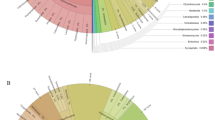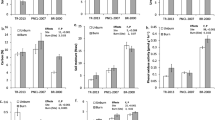Abstract
Active management to encourage the expansion of native pine woodland onto neighbouring moorland has been suggested as a tool to promote increases in forest area to combat climate change. Low intensity burning has previously been shown to increase pine seedling establishment, however the effect of this on below-ground diversity and functioning in these important terrestrial carbon stores is equivocal. Here, we assessed the effect of a single burn and grazing exclosures after a 6 year period on soil microbial respiratory activity and fungal community structure using terminal restriction fragment polymorphism (T-RFLP) analysis. The combined data suggest that the strategy of a single prescribed burn to facilitate Scots pine establishment had no lasting effect on either fungal taxonomic richness, fungal community composition or microbial activity. Thus, our findings support the proposed use of single, low intensity, prescribed burns in regenerating Scots pine forests as a low impact management tool.


Similar content being viewed by others
Abbreviations
- T-RFLP:
-
Terminal restriction fragment length polymorphism
- TRF:
-
Terminal restriction fragment
- SIR:
-
Substrate induced respiration
- NAGA:
-
N-acetyl glucosamine
- GABA:
-
γ-aminobutyric acid
- ITS:
-
Internal transcribed spacer region
- ANOVA:
-
Analysis of variance
References
Acea MJ, Carballas T (1996) Changes in physiology of groups of microorganisms in soil following wildfire. FEMS Microbiol Ecol 20:33–39
Amphlett A, Holden E, Allcorn R, Gurney M (2006) Effects of cutting and burning of heather Calluna vulgaris on fungal fruiting in Caledonian pine forest at Abernethy Forest RSPB reserve, Inverness-shire, Scotland. Conservation Evidence 3:106–108
Anderson MJ (2001) A new method of non-parametric multivariate analysis of variance. Austral Ecol 26:32–46
Anderson IC, Campbell CD, Prosser JI (2003) Diversity of fungi in organic soils under a moorland—Scots pine (Pinus sylvestris L.) gradient. Environ Microbiol 5:1121–1132
Anderson IC, Parkin PI (2007) Detection of active soil fungi by RT-PCR amplification of precursor rRNA molecules. J Microbiol Meth 68:248–253
Anderson IC, Parkin PI, Campbell CD (2008) DNA- and RNA-derived assessments of fungal community composition in soil amended with sewage sludge rich in cadmium, copper and zinc. Soil Biol Biochem 40:2358–2365.S
Anderson IC, Bastias BA, Genney DR, Parkin PI, Cairney JWG (2007) Basidiomycete fungal communities in Australian sclerophyll forest soil are altered by repeated prescribed burning. Mycol Res 111:482–486
Artz RRE, Anderson IC, Chapman SJ, Hagn A, Schloter M, Potts JM, Campbell CD (2007) Changes in fungal community composition in response to vegetational succession during the natural regeneration of cutover peatlands. Microb Ecol 54:508–522
Artz RRE, Reid E, Anderson IC, Campbell CD, Cairney JWG (2009) Long term repeated prescribed burning increases evenness in the basidiomycete laccase gene pool in forest soils. FEMS Microbiol Ecol 67:397–410
Bååth E, Frostegård Å, Pennanen T, Fritze H (1995) Microbial community structure and pH response in relation to soil organic matter quality in wood-ash fertilized, clear-cut or burned coniferous forest soils. Soil Biol Biochem 2:229–240
Bastias BA, Xu Z, Cairney JWG (2006a) Influence of long-term repeated prescribed burning on mycelial communities of ectomycorrhizal fungi. New Phytol 172:149–158
Bastias BA, Huang ZQ, Blumfield T, Xu Z, Cairney JWG (2006b) Influence of repeated prescribed burning on the soil fungal community in an eastern Australian wet sclerophyll forest. Soil Biol Biochem 38:3492–3501
Bastias BA, Anderson IC, Xu Z, Cairney JWG (2007) RNA and DNA- based profiling of soil fungal communities in a native Australian eucalypt forest and adjacent Pinus eliotti plantation. Soil Biol Biochem 39:3108–3114
Bastias BA, Anderson IC, Rangel-Castro JI, Parkin PI, Prosser JI, Cairney JWG (2009) Influence of repeated prescribed burning on incorporation of 13C from cellulose by forest soil fungi as determined by RNA stable isotope probing. Soil Biol Biochem 41:467–472
Bennett KD (1984) Post glacial history of Pinus sylvestris in Scotland. Quat Sci Rev 3:133–155
Bergner B, Johnstone J, Treseder KK (2004) Experimental warming and burn severity alter soil CO2 flux and soil functional groups in a recently burned boreal forest. Glob Chang Biol 10:1996–2004
Bettucci L, Alonso R (1995) The effect of wildfire on the opportunistic decomposer fungal community of a Uruguayan Eucalyptus spp. forest. Pedobiologia 39:470–480
Bougoure DS, Parkin PI, Cairney JWG, Alexander IJ, Anderson IC (2007) Diversity of fungi in hair roots of Ericaceae varies along a vegetation gradient. Mol Ecol 16:4624–4636
Cairney JWG, Meharg AA (1999) Influences of anthropogenic pollution on mycorrhizal fungal communities. Environ Pollut 106:169–182
Cairney JWG, Bastias BA (2007) Influences of fire on forest soil fungal communities. Can J For Res 37:207–215
Campbell CD, Chapman SJ, Cameron CM, Davidson MS, Potts JM (2003) A rapid microtitre plate method to measure carbon dioxide evolved from carbon substrate amendments so as to determine the physiological profiles of soil microbial communities by using whole soil. Appl Environ Microbiol 69:3593–3599
Campbell CD, Cameron CM, Bastias BA, Chen C, Cairney JWG (2008) Long term repeated burning in a wet sclerophyll forest reduces fungal and bacterial biomass and responses to carbon substrates. Soil Biol Biochem 40:2246–2252
Chapman SJ, Campbell DD, Fraser AR, Puri G (2001) FTIR spectroscopy of peat in and bordering Scots pine woodland: relationship with chemical and biological properties. Soil Biol Biochem 33:1193–1200
Chapman SJ, Campbell DD, Puri G (2003) Native woodland expansion: soil chemical and microbiological indicators of change. Soil Biol Biochem 35:753–764
Chen DM, Cairney JWG (2002) Investigation of the influence of prescribed burning on ITS profiles of ectomycorrhizal and other soil fungi at three Australian sclerophyll forest sites. Mycol Res 106:532–540
Curlevski NJA, Xu ZH, Anderson IC, Cairney JWG (2009) Converting Australian tropical rainforest to native Araucariaceae plantations alters soil fungal communities. Soil Biol Biochem 42:14–20
Fonturbel MT, Vega JA, Bara S, Bernardez I (1995) Influence of prescribed burning of pine stands in NW Spain on soil microorganisms. Eur J Soil Biol 31:13–20
Gardes M, Bruns TD (1993) ITS primers with enhanced specificity for basidiomycetes application to the identification of mycorrhizae and rusts. Mol Ecol 2:113–118
Gibson DJ, Hetrick BAD (1988) Topographic and fire effects on the composition and abundance of VA-mycorrhizal fungi in tallgrass prairie. Mycologia 80:433–441
Griffiths RI, Whiteley AS, O’Donnel AG, Bailey MJ (2000) Rapid methods for coextraction of DNA and RNA from natural environments for analysis of ribosomal DNA- and rRNA-based microbial community composition. Appl Environ Microbiol 66:5488–5491
Grogan P, Baar J, Bruns TD (2000) Below-ground ectomycorrhizal community structure in a recently burned bishop pine forest. J Ecol 88:1051–1062
Hancock M, Egan S, Summers R, Cowie N, Amphlett A, Rao S, Hamilton A (2005) The effect of experimental prescribed fire on the establishment of Scots pine Pinus sylvestris seedlings on heather Calluna vulgaris moorland. For Ecol Manag 212:199–213
Hancock MH, Summers RW, Amphlett A, Willi J (2009) Testing prescribed fire as a tool to promote Scots pine Pinus sylvestrus regeneration. Eur J Forest Res 128:319–333
Hart SC, DeLuca TH, Newman GS, MacKenzie MD, Boyle SI (2005) Post-fire vegetative dynamics as drivers of microbial community structure and function in forest soils. For Ecol Manag 220:166–184
Hobbs RJ, Gimmingham CH (1987) Vegetation, fire and herbivore interactions on heathland. Adv Ecol Res 16:87–173
Holden J, Shotbolt L, Bonn A, Burt TP, Chapman PJ, Dougill AJ, Fraser EDG, Hubacek K, Irvine B, Kirkby MJ, Reed MS, Prell C, Stagl S, Stringer LC, Turner A, Worrall F (2007) Environmental change in moorland landscapes. Earth Sci Rev 82:75–100
Klump K, Fontaine S, Attard E, Le Roux XM, Gleixner G, Soussana JF (2009) Grazing triggers soil carbon loss by altering plant roots and their control on soil microbial community. J Ecol 97:876–885
Korkama-Rajala T, Müller MM, Pennanen T (2007) Decomposition and fungi of needle litter from slow- and fast-growing Norway spruce (Picea abies) clones. Microb Ecol 56:76–89
Martin-Pinto P, Vaquerizo H, Peňalver F, Olaizola J, Oria-de-Rueda JA (2006) Early effects of a wildfire on the diversity and production of fungal communities in Mediterranean vegetation types dominated by Citrus ladanifer and Pinus pinaster in Spain. For Ecol Manag 225:296–305
Mason WL, Hampson A, Edwards C (2004) Managing the Pinewoods of Scotland. Forestry Commission, Edinburgh
Mohamed A, Härdtle W, Jirjahn B, Niemeyer T, von Oheimb G (2007) Effects of prescribed burning on plant available nutrients in dry heathland ecosystems. Plant Ecol 189:279–289
Newton AC, Stewart GB, Myers G, Diaz A, Lake S, Bullock JM, Pullin AS (2009) Impacts of grazing on lowland heathland in north-west Europe. Biol Conserv 142:935–947
Niemeyer T, Niemeyer M, Mohamed A, Fottner S, Hardtle W (2005) Impact of prescribed burning on the nutrient balance of heathlands with particular reference to nitrogen and phosphorus. Appl Veg Sci 8:183–192
Östlund L, Zackrisson O, Axelsson AL (1997) The history and transformation of a Scandanavian boreal forest landscape since the 19th century. Can J For Res 27:1198–1206
Rowell MJ (1995) Colorimetric method for CO2 measurement in soils. Soil Biol Biochem 27:373–375
Saari TA, Saari SK, Campbell CD, Alexander IJ, Anderson IC (2007) FragMatch-a program for the analysis of DNA fragment data. Mycorrhiza 17:133–136
SEERAD (2001) The muirburn code. Scottish Executive, Edinburgh
Stendell ER, Horton TR, Bruns TD (1999) Early effects of prescribed fire on the structure of the ectomycorrhizal fungus community in a Sierra Nevada ponderosa pine forest. Mycol Res 103:1353–1359
Thormann MN (2006) Diversity and function of fungi in peatlands: a carbon cycling perspective. Can J Soil Sci 86:281–293
Toberman H, Freeman C, Evans C, Fenner N, Artz RRE (2008) Summer drought decreases soil fungal diversity and associated pheol oxidase activity in upland Calluna heathland soil. FEMS Microbiol Ecol 66:426–436
Tucker G (2004) The burning of the uplands and its effect on wildlife. Br Wildl 15:251–257
Vásquez FJ, Acea MJ, Carballas T (1993) Soil microbial populations after wildfire. FEMS Microbiol Ecol 13:93–104
Waldrop MP, Harden JW (2008) Interactive effects of wildfire and permafrost on microbial communities and soil processes in an Alsakan black spruce forest. Glob Chang Biol 14:2591–2602
White TJ, Bruns TD, Lee S, Taylor S (1990) Amplification and direct sequencing of fungal ribosomal DNA genes for phylogenetics. In: Innis MA, Sninsky DH, White TJ (eds) PCR protocols. Academic, London, pp 315–322
Wilson B, Puri G (2001) A comparison of pinewood and moorland soils in the Abernethy Forest Reserve, Scotland. Glob Ecol Biogeogr 10:291–303
Yallop AR, Thacker JI, Stephens M, Clutterbuck B, Brewer T, Sannier CAD (2006) The extent and intensity of management burning in the English uplands. J Appl Ecol 43:1138–1148
Acknowledgements
This work was supported by an Australian Postgraduate Award (NJAC), an ARC Discovery Projects Grant (JWGC), an ARC Linkage International Awards Grant (JWGC and ICA) and a Macaulay Development Trust collaboration grant (ICA). NJAC also acknowledges the UWS Centre for Plant and Food Science for providing additional scholarship funding. The Macaulay Institute is supported by the Scottish Government. We are grateful the scientific cooperation of SNH and RSPB at Abernethy Nature Reserve.
Author information
Authors and Affiliations
Corresponding author
Additional information
Responsible Editor: Paul Bodelier.
Rights and permissions
About this article
Cite this article
Curlevski, N.J.A., Artz, R.R.E., Anderson, I.C. et al. Response of soil microbial communities to management strategies for enhancing Scots pine (Pinus sylvestris) establishment on heather (Calluna vulgaris) moorland. Plant Soil 339, 413–424 (2011). https://doi.org/10.1007/s11104-010-0593-x
Received:
Accepted:
Published:
Issue Date:
DOI: https://doi.org/10.1007/s11104-010-0593-x




